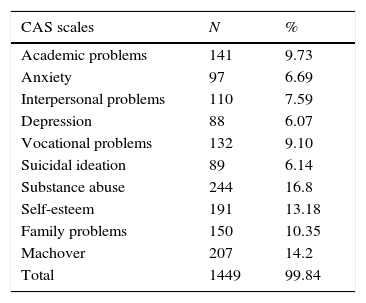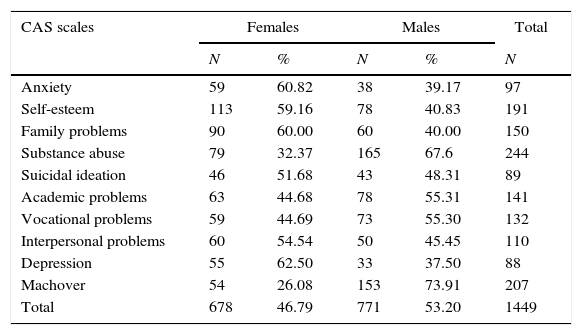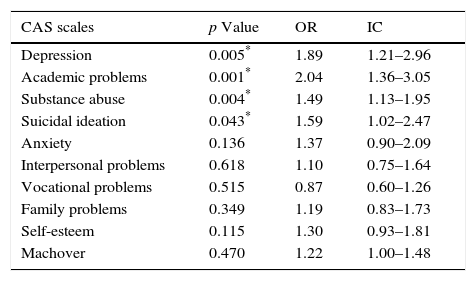Admission to a degree program represents a challenge for new students, which those that show greater emotional stability and ability to face school adjustment will best solve. The Draw a Person test and Anton and Reed's College Adjustment Scales (CAS) questionnaire was applied to 2364 first year students of a Medical School in northeastern México admitted during the years 2013 and 2014. One or more abnormal scales were documented in 674 students (28.4%). A correlation study between 1000 students with normal scales and the 674 students with abnormal scales was performed. The group with normal tests had a greater number of student approval (64% vs 46.9%) p=0.03. A significant correlation was found with school failure in four of the CAS abnormalities: depression (p=0.005), academic problems (p=0.001) substance abuse (p=0.004) and suicidal ideation (p=0.043). We concluded that the evidence of depression, academic problems, substance abuse and suicidal ideation were associated statistically with low academic performance in the study population.
Academic performance is defined as the fulfillment of the goals, accomplishments, or targets set in the program or course in which a student is enrolled. One of the problems of greatest interest in higher education in Mexico is the high dropout rate of students.1–3 The period in which the largest percentage drop occurs happens in the early years of their university career periods, especially critical because young people are in a new evolutionary stage, known as emerging adulthood.4 This stage is characterized by high instability, anxiety, and the seeking and exploration of identity. Access to higher education in this stage of development brings new social problems to young people, such as separation from family and friends, creating new friendships, and demands for greater autonomy.5 The effects of these changes, as well as increasing academic demands, hinders successful adaptation to the university and is a condition for successful permanence in it. Recent studies highlight social support as one of the most important protective factors against disturbing or adverse experiences arising from incorporation into the university.6 There are two essential aspects of social support: the perception that you have a number of people who can be called upon in case of need and satisfaction with that support. Some students require the support of a greater number of people to show satisfaction, while for others the support of one person is enough. In this study, adaptation to the university was studied using the questionnaire known as the College Adjustment Scale (CAS) developed by Anton and Reed in 1991,7 and the Draw a Person test by Machover.7
ObjectiveUnderstand the students’ capacity to adapt to the university environment upon entering of a Medical School in northeastern México and determine if there is a statistical relationship with school failure.
Material and methodsThe Anton and Reed CAS questionnaire7 and Machover's Draw a Person test8 was applied to 2250 (95.2%) students in the admission process to the School of Medicine and 114 (4.8%) in the Clinical Laboratory Sciences (CLS) for a total of 2364 students. The CAS has 108 reactives, divided into nine adjustment scales: anxiety, depression, suicidal ideation, substance abuse, self-esteem, interpersonal problems, family problems, academic problems and problems in vocational career choice. The students answered on the basis of four points: 1 (totally false); 2 (often false); 3 (almost always true); and 4 (totally true). Each of the nine scales consists of 12 questions, with a minimum score of 12 and a maximum score of 48. The highest results indicate low settings and the lowest results mean better adjustment.8 The test was translated, standardized and adapted to the population of medical students from the classes that joined in August, 2013, February, 2014 and August, 2014. The results were normal for 1690 (71.5%) students, and 674 (28.4%) had one or more abnormal results. The Machover test, or the Draw a Person test, was assessed based on a rating of 1–5, with 1–3 being normal and 4–5 being abnormal. A representative sample of students with normal results (1000–1690) was taken, and all students with abnormal results (674) were correlated with their academic performance, taking as a basis an average of 70 or more obtained during their semester. Statistical analysis included: descriptive frequency analysis, Pearson correlation index, p-value, χ2 test, and estimation of relative risk.
ResultsThe number of male students was 1335 (56.5%) and 1028 female students (43.5%) were included in this study. Normal results were documented in 1690 students (71.5%) and abnormal results in one or more of the scales in 674 (28.4%). Distribution and percentage of scales that were abnormal can be seen in Table 1. In six of the scales, a difference was found by gender as follows: depression (62.5%), anxiety (60.8%), family problems (60%) and self-esteem (59.1%) were more frequent in women, and abnormalities in substance abuse (67.6%) and the Mechover test (73.9%) were the most prevalent among men (Table 2). Considering the passing grade with a value of 70, we found that in the group with normal results on their tests, a total of 640 respondents passed (64%) and 360 flunked (36%), and in the group of students with abnormal CAS scores, 316 students passed(46.9%) and 358 flunked (53%), with a difference of p<0.01 (Table 3). The correlation of the results of the CAS scales with the average grades achieved during the first semester showed a statistically significant relationship with 4 scales: depression, academic problems, substance abuse and suicidal ideation. Academic problems showed the greatest risk (OR=2.04, p<0.001), followed by depression (OR=1.89, p<0.005), substance abuse (OR=1.49, p<0.004) and suicidal ideation (OR=1.59, p<0.043) (Table 4).
Distribution of CAS scales and altered Machover tests in 674 students of the School of Medicine.
| CAS scales | N | % |
|---|---|---|
| Academic problems | 141 | 9.73 |
| Anxiety | 97 | 6.69 |
| Interpersonal problems | 110 | 7.59 |
| Depression | 88 | 6.07 |
| Vocational problems | 132 | 9.10 |
| Suicidal ideation | 89 | 6.14 |
| Substance abuse | 244 | 16.8 |
| Self-esteem | 191 | 13.18 |
| Family problems | 150 | 10.35 |
| Machover | 207 | 14.2 |
| Total | 1449 | 99.84 |
CAS scales and altered Machover tests by gender.
| CAS scales | Females | Males | Total | ||
|---|---|---|---|---|---|
| N | % | N | % | N | |
| Anxiety | 59 | 60.82 | 38 | 39.17 | 97 |
| Self-esteem | 113 | 59.16 | 78 | 40.83 | 191 |
| Family problems | 90 | 60.00 | 60 | 40.00 | 150 |
| Substance abuse | 79 | 32.37 | 165 | 67.6 | 244 |
| Suicidal ideation | 46 | 51.68 | 43 | 48.31 | 89 |
| Academic problems | 63 | 44.68 | 78 | 55.31 | 141 |
| Vocational problems | 59 | 44.69 | 73 | 55.30 | 132 |
| Interpersonal problems | 60 | 54.54 | 50 | 45.45 | 110 |
| Depression | 55 | 62.50 | 33 | 37.50 | 88 |
| Machover | 54 | 26.08 | 153 | 73.91 | 207 |
| Total | 678 | 46.79 | 771 | 53.20 | 1449 |
Relation between normal and abnormal CAS results in 1674 passing and failing students.
| CAS test | Passed | Failed | ||
|---|---|---|---|---|
| N | % | N | % | |
| Normal | 640 | 64.0* | 360 | 36.0 |
| Abnormal | 316 | 46.9 | 358 | 53.1 |
Correlation between CAS scales and Machover tests with school performance.
| CAS scales | p Value | OR | IC |
|---|---|---|---|
| Depression | 0.005* | 1.89 | 1.21–2.96 |
| Academic problems | 0.001* | 2.04 | 1.36–3.05 |
| Substance abuse | 0.004* | 1.49 | 1.13–1.95 |
| Suicidal ideation | 0.043* | 1.59 | 1.02–2.47 |
| Anxiety | 0.136 | 1.37 | 0.90–2.09 |
| Interpersonal problems | 0.618 | 1.10 | 0.75–1.64 |
| Vocational problems | 0.515 | 0.87 | 0.60–1.26 |
| Family problems | 0.349 | 1.19 | 0.83–1.73 |
| Self-esteem | 0.115 | 1.30 | 0.93–1.81 |
| Machover | 0.470 | 1.22 | 1.00–1.48 |
One of the problems of greatest interest in higher education in Mexico is the high failure rate of its students. The CAS (The College Adjustment Scale) questionnaire, created by Anton and Reed in 1991, can quickly assess some problems that can affect adaptation to the university environment. In this study, four scales correlating significantly with low student learning were found: depression, academic problems, substance abuse and suicidal ideation. All of them associated with common etiological factors such as stress and the inability to adapt, low self-esteem and emotional deprivation.
Depression is a serious problem in university students. The university environment presents many goals and challenges, which the student must meet to learn new skills.9 Students, when they are depressed, experience poor concentration, pessimism, low self-esteem and loss of energy.10 It is estimated that depression affects up to 30% of students in the university population, and about 15% experience clinical levels of depression.11,12 Depressed students have more problems with college work and low motivation.13 Depression is more common in women and is related to low self-esteem, emotional and behavioral problems, as well as difficulties in academic performance.14,15 The use of alcohol and other drugs in adolescence has increased in Mexico in recent years and is the subject of social concern. The cause of substance abuse in adolescence is very complex, involving the deficit in the process of decision making, the negative influence of peers and adults who act as role models, the adolescent's emotional deprivation and the distance from their family.16 Among the problems arising from the use of substances are not only their schooling,17 but also unplanned pregnancies, sexually transmitted diseases,18 emotional19 and legal problems.20 Botvin21 showed that by avoiding adolescents’ exposure to illicit substances, we can reduce absenteeism and improve school grades compared to a control group. Suicidal ideation in adolescence is frequent, and usually comes from stress, which has a detrimental psychological and physical effect, acting as a factor that triggers or exacerbates various symptoms such as low tolerance to frustration, anxiety, depression, fear, etc. Perez-Amezcua et al. studied 14,306 students from 149 schools22 and found that nearly half of students in upper secondary education in Mexico had suicidal thoughts and that 9% had attempted suicide. Among the predisposing factors were sexual abuse, depression and consumption of snuff and drugs. Jiménez, and González-Forteza Mondragon,23 also in Mexico, found that the risk of suicidal ideation is higher in women, twice as much in relation to men; when they have low self-esteem, the risk increases by four times, and if there are depressive symptoms, the risk is thirteen times higher. In our study, we found no gender difference on this scale.
On the scale of academic problems, the students’ previous experiences in this area were analyzed, as well as their study habits, concentration, time management skills, and satisfaction with academic achievements, also their confidence in their ability to learn and remember at the time of examination. It is known that many students that enter the university, cannot meet the new challenges of better organization of academic work, planning time and greater dedication to study, which entails a higher risk of school failure.24,25 We must mention the importance of family problems in the school's students, as an open and fluid communication between parents and the student can help as a protective effect and positively influence their psychological well-being and adjustment to the school.26 A harsh family environment is linked to the development of depressive symptoms and poor academic performance.27 These factors together could explain the results and behavior of the students with abnormal results which were detected in the study.
ConclusionsOf the scales studied in our CAS test, depression, academic problems, substance abuse and suicidal ideation were associated with statistically greater failure rates in the studied student population. This shows that there is an increased risk of low academic performance if the student has one or more of these four altered scales. The Draw a Person test had no correlation with school failure. The application, review and analysis of such standardized tests enable us to get to know the new student population better, detecting risk factors for poor school performance, and implementing strategies to strengthen personal ties, and academic and psychological support, to facilitate their adaptation to the college and improve academic performance.
Ethical disclosuresProtection of human and animal subjectsThe authors declare that no experiments were performed on humans or animals for this study.
Confidentiality of dataThe authors declare that no patient data appear in this article.
Right to privacy and informed consentThe authors declare that no patient data appear in this article.
FundingNo financial support was provided.
Conflict of interestThe authors have no conflicts of interest to declare.







